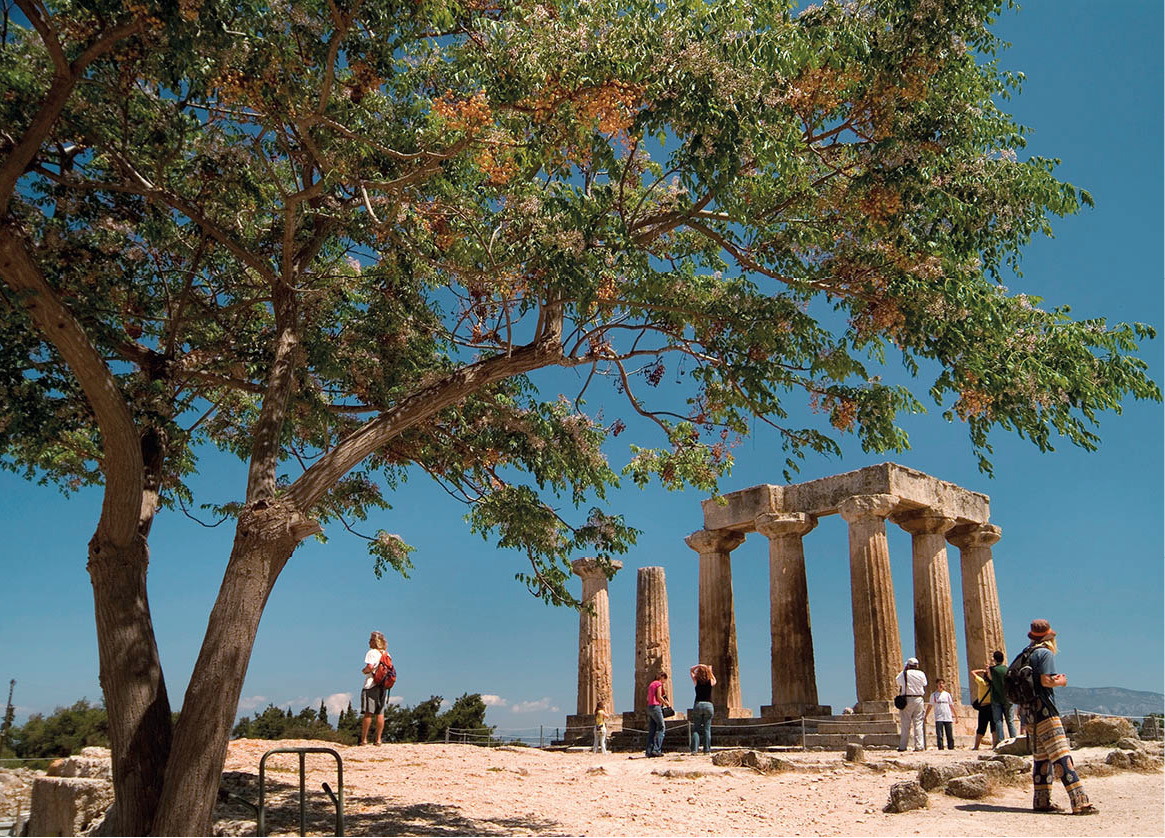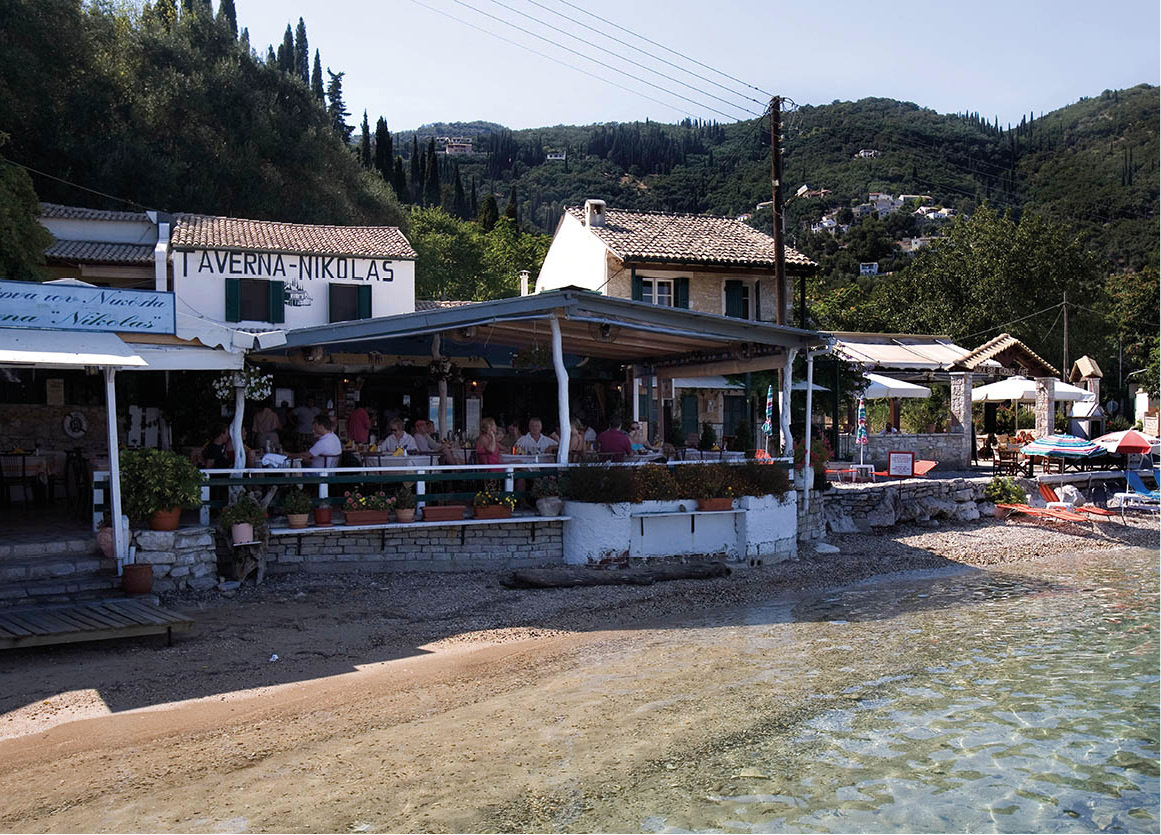Italians are very proud of being the source of many of Europe’s greatest cultural traditions – ancient Rome itself, the Renaissance, opera – and virtually every town has its historic buildings and artistic highlights. Italy also offers a remarkable range of landscapes, from Alpine peaks and the wild empty crags of the Abruzzo to the flat, misty plains of the Po Valley or brilliantly white sand beaches.
Alpine regions
Travellers arriving from Austria through the Brenner Pass 1 [map] may not immediately notice much difference. The Alpine landscape of wooden chalets and onion-domed churches appears more Austrian than Italian, and most of the people in this region, the Alto Adige or the South Tyrol, speak German and maintain distinctly Germanic traditions and hearty mountain cuisine. It became Italian, essentially, because Italy was one of the victors in World War I. Today it is officially bilingual and enjoys administrative autonomy, and both languages mix in the vibrant regional capital of Bolzano (or Bolzen, in German).
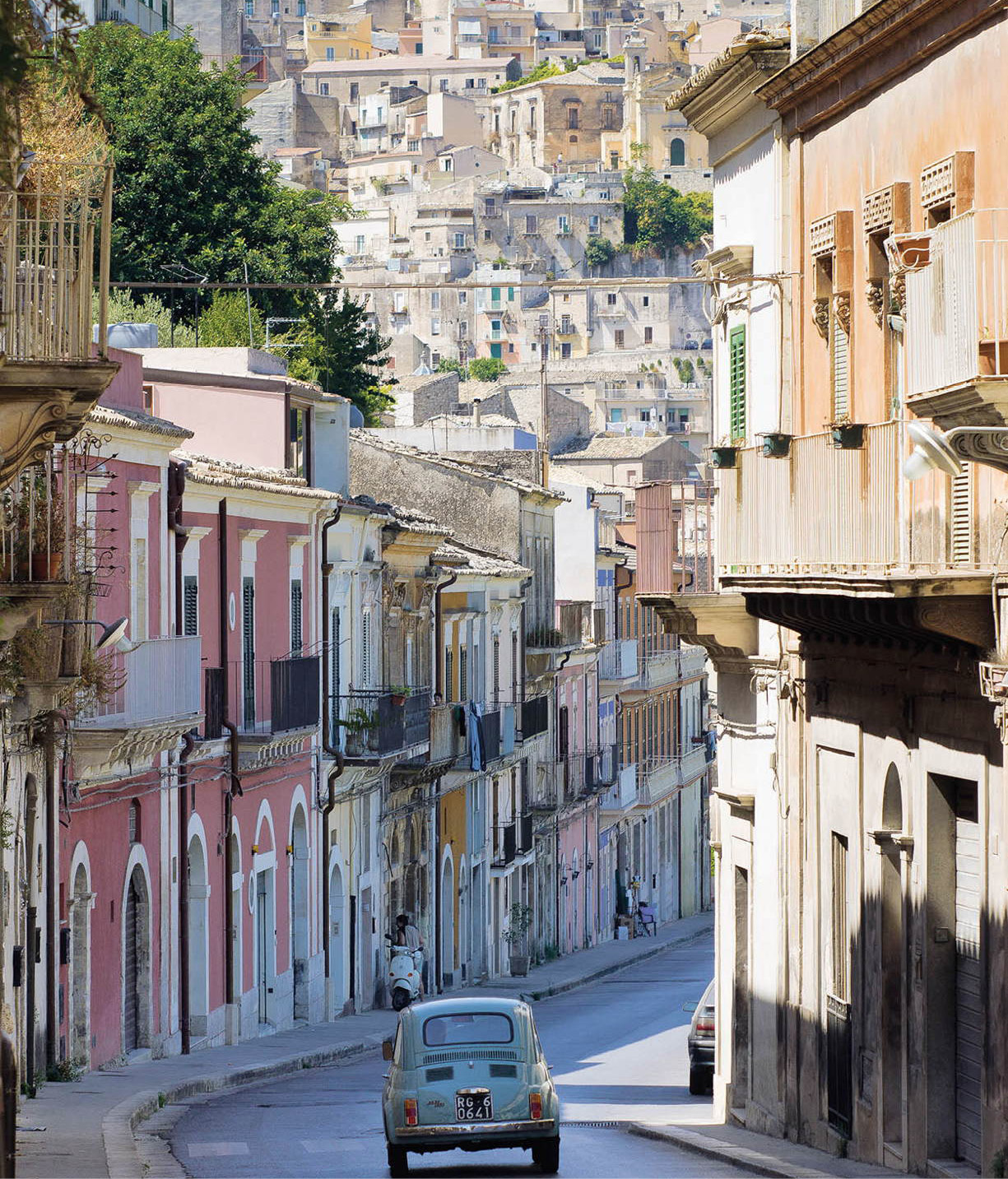
Driving through Ragusa Ibla in Sicily.
Neil Buchan-Grant/Apa Publications
To the east Italian dialects become more prevalent in the Dolomites, the most spectacular range in the Italian Alps. The valley of Val Gardena, with popular winter resorts such as Ortisei or Selva, leads up and up to the Sella Pass, at 2,244 metres (7,360ft), to meet the dramatic switchback Great Dolomite Road to the chic and world-famous ski resort of Cortina d’Ampezzo. The Dolomites are as renowned for summer hiking as for winter sports, especially the ranges south of Cortina, with a wonderful range of high-mountain paths including vie ferrate, precarious paths of iron cables and ladders that were built into mountainsides by the Italian army during World War I.
South of Bolzano, the Brenner Highway runs down past castles and fortifications medieval Trento 2 [map], famous for the “Council of Trent” held here over 19 years, from 1545 to 1563, which launched the Catholic Counter-Reformation. It has a Romanesque Duomo (Cathedral; daily) and the Castello del Buon Consiglio (Castle of Good Counsel; Tue–Sun), a 13th-century castle with remarkable medieval frescoes depicting the Cycle of the Months, which also houses touring exhibitions.
Skiing in the Dolomites
Dubbed the world’s loveliest winter playground, the Dolomites do not disappoint. Even the kitsch après-ski is the perfect relaxation after days spent among the stark peaks and spires of the mountains. The resorts, with a few celebrity-studded exceptions such as Cortina d’Ampezzo or Madonna di Campidoglio, are stylish rather than snooty; cosy rather than blasé. The Dolomiti Superski (www.dolomitisuperski.com) centred on Cortina is the world’s biggest skiing region, offering 1,220km (760 miles) of pistes around 16 different centres, with the 26km (16-mile) Sella Ronda circuit the jewel in the crown. Resorts en route include Ortisei, Selva and ritzy Alta Badia above Val Gardena. The Dolomite resorts also offer superb food, from hearty Tyrolean feasts in Alpine inns to Michelin-starred fare in the restaurants of the Alta Badia.
The Veneto and Trieste
As you leave the mountains and enter the green plains of the Veneto, roads converge on Verona 3 [map], where, according to Shakespeare, Romeo and Juliet lived and loved. Their story is of course a beautiful fiction (though local families called something like Montague and Capulet did exist), but Verona delights in its romantic connections, and thousands visit Casa di Giulietta (Juliet’s House; Mon pm, Tue–Sun) at Via Cappello 23, a real medieval townhouse, with balcony, of the kind Juliet could have inhabited. Modern Verona is also one of the most prosperous towns in Italy, with plenty of other attractions. In the centre of town, beside the animated main square the Piazza Brà, is the Roman Arena, built in the 1st century AD but wonderfully well preserved. Each summer it provides an unforgettable setting for an enormously popular opera season. The narrow streets north of the Arena, in a bend of the River Adige, are delightful for strolling and window-shopping.
Tip
Verona’s open-air opera season in the fantastic setting of the Roman Arena runs from early July to mid-September. Each year it features some of the leading figures in the opera world, and in 2013 will celebrate its centenary, with Plácido Domingo as artistic director. Tickets can be booked up to a year in advance through www.arena.it.
A short distance to the east is Vicenza, a city associated above all with one architect, Andrea Palladio (1508–1580), who from the 1540s was given extraordinary freedom by its merchant-rulers to redesign their town, reviving the proportions of Roman builders and so effectively creating the Neoclassical style in architecture, emulated across Europe for the next 300 or more years. Palladio’s masterpieces begin on the main square, Piazza dei Signori, with the exquisite Basilica – not a church but a seat of government and justice, the original Roman meaning of the word – with two-storey loggia, and continue with the palazzi on Corso Palladio, the main street, which leads to his last great construction, the Teatro Olimpo, the oldest intact indoor theatre in the world. Palladio was also famed for the country villas he built for noble families, imitated in many English stately homes. Many can be seen in the countryside to the east towards Treviso, or along the Brenta Canal south of Venice.
A mainland “partner” to Venice for centuries, the lovely city of Padua 4 [map] (Padova) also looms large in Shakespeare, as, among other scenes, the setting for Katherine’s challenge to the male order in Shakespeare’s The Taming of the Shrew. An important city since ancient times, with Italy’s second-oldest university (established in 1222), it is also the resting place of St Anthony of Padua, a Franciscan preacher whose remains draw pilgrims to the immense Basilica di Sant’Antonio (daily). In the town centre on the Piazza delle Erbe, the 12th–13th-century town hall, Palazzo della Ragione (Tue–Sun) has the largest medieval hall in Europe. Padua’s greatest treasures, though, are Giotto’s beautifully preserved frescoes from 1305 in the Scrovegni Chapel (daily; reservations compulsory; www.cappelladegliscrovegni.it).
From Padua it is a short hop to Venice 5 [map] (Venezia), and the Adriatic coast. In northern Italy’s easternmost corner, Trieste 6 [map] has been subjected to many ownership disputes, and was the last major city to be incorporated into the country, after World War I. None of this bothered Irish writer James Joyce when he arrived in the city in 1905, when it was part of the Austrian Empire. He thought his stay would be a short one, but Trieste became his home for 10 years. Among Trieste’s attractions today are its curious Italian-central European architectural mix, and its many Old World cafés.
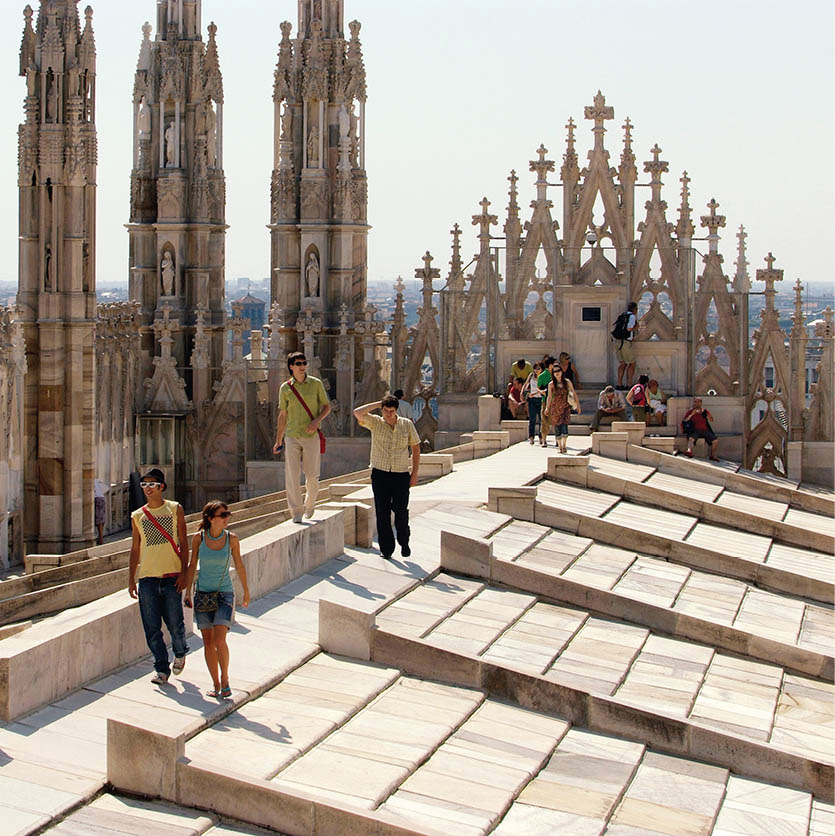
On the roof of Milan Cathedral.
Glyn Genin/Apa Publications
Milan, Piedmont and Liguria
A web of highways and rail lines speeds into Milan 7 [map] (Milano), Italy’s second-biggest city after Rome, which, perhaps understandably, regards itself as the country’s true capital. Not only is it the centre of industry and finance, but it has forged ahead to become the country’s most dynamic and influential city in everything but pure politics. Milan is also the hub of Italian fashion, and very conscious of its stylish status.
The city’s most famous landmark is, nevertheless, the gargantuan Duomo (Cathedral; daily), one of the largest of all Gothic cathedrals, with a soaring facade of multiple spires and an interior of giant columns. Outside, on the north side of the main square, Piazza del Duomo, is a cathedral of another kind, the Galleria Vittorio Emanuele, Italy’s most beautiful 19th-century shopping arcades. On the south side of the square, the Museo del Novecento (Museum of the 20th Century; Mon pm, Tue–Sun), opened in 2010, exhibits a superb collection of modern art, highlighting the role of Italian artists such as Modigliani, Di Chirico or Boccioni but also featuring works by Picasso, Matisse, Mondrian and many others.
North of the Galleria Vittorio are La Scala, sumptuous centre of the world of opera, and the Pinacoteca di Brera (Tue–Sun), another august art collection housed in a 16th-century palace, with art from the 15th to the 19th centuries including Raphael’s Marriage of the Virgin and Caravaggio’s Supper at Emmaus. Milan’s most famous artistic possession by far, though, is in the west of the city in the Cenacolo Vinciano (Tue–Sun; reservations essential, from www.vivaticket.it, tel: 02-9280 0360, or ticket agencies). This former monk’s refectory attached to the church of Santa Maria delle Grazie contains Leonardo da Vinci’s Last Supper; the restoration of the mural in the 1990s has attracted huge criticism, but it still has an awe-inspiring power.
On the east side of the centre, in contrast, is the heart of fashionable Milan. Via Montenapoleone and the streets around it are home to an enticing range of designer shops, large and small.
Turin 8 [map] (Torino) was capital of the Piedmontese kingdom under which Italy was united in 1860, and so was for a time the whole country’s first capital. It still likes to challenge larger Milan as the capital of Italian industry, and to keep up with it as one of Italy’s most stylish cities. The centre of fashionable strolling and shopping in Turin is Via Roma, the long main street that runs up to the disproportionately large Piazza Castello and former Palazzo Reale (Royal Palace; Tue–Sun). Next to the palace, the Renaissance Duomo (Cathedral) safeguards one of Italy’s most famous relics, the much-contested Holy Shroud. Modern Turin is also inseparable from car making (especially Fiats), and near the company’s former Modernist factory – now an arts centre – at Lingotto south of Turin (as featured in The Italian Job), the Museo Nazionale dell’Automobile is one of the world’s biggest motor museums.
The lush Piedmontese countryside around Turin is famous for fine food and drink. Alba is the capital of truffles, while Barolo is noted for red wines and Asti is Italy’s foremost producer of sparkling wines. In the northwest, the Valle d’Aosta is another of Italy’s prime Alpine winter sports regions, with attractive resorts like Courmayeur beneath Mont Blanc.
A line of mountains separates Piedmont from the Mediterranean and Liguria, centred on the ancient maritime republic of Genoa 9 [map] (Genova), Italy’s busiest port. Sandwiched between mountains and the sea, Old Genoa has a unique layout, with a web of long but narrow streets, and a distinctively tangy, maritime atmosphere. The 12th-century Romanesque Duomo (Cathedral) was built with horizontal white and dark bands in the exterior, and Moorish-influenced columns inside. The once run-down Porto Antico (Old Harbour) has been extensively renovated since the 1990s, and has a futuristic Acquario (Aquarium; daily) by Genoa-born architect Renzo Piano.
Either side of Genoa along the coast is the Italian Riviera, with towns that have been fashionable summer resorts since the 19th century. To the west, San Remo retains an air of sophistication, while Bordighera is more charming. East of Genoa the coast is steeper and the villages prettier and less traditionally developed: gorgeous but exclusive Portofino and the idyllic cliff-hanging villages called the Cinque Terre are well known.
Across the foothills of the Alps above Milan are the Italian Lakes, made up of five major lakes. The most westerly is Lago Maggiore A [map] (Lake Maggiore), with the grande dame resort of Stresa B [map] on its western shore. From here it’s a quick ferry hop to the Borromean Islands C [map] (Apr–Oct daily) and a short drive or cable-car ride from Stresa Lido to the top of Monte Mottarone, for a wonderful panorama of the lakes and Alps.
On the far side of Monte Mottarone lies little Lago di Orta D [map] (Lake Orta), the setting of the perfectly preserved medieval village of Orta San Giulio, with mesmerising views across the lake to Isola San Giulio.

The western shore of Lake Garda.
Neil Buchan-Grant/Apa Publications
The most visually stunning of the lakes is Lago di Como E [map], almost 50km (30 miles) long and up to 5km (3 miles) wide. The Alps enclose the lake to the north and skiers enjoy unparalleled views as they whoosh down the glaciers. Ferries are the best way of seeing the lake. From the town of Como F [map] you can take a slow, scenic cruise north to Bellagio G [map], “pearl of the lake”, which enjoys sublime views of the Alps from its setting on a peninsula that separates the Y-shaped lake’s two arms. Grand old villas and luxuriant gardens line the lakeshores of Como, the most celebrated among them Villa Carlotta at Tremezzo (Apr–Oct daily), across the water from Bellagio.
Southeast of Lake Como is Bergamo H [map], which has one of Italy’s most enchanting medieval centres, reached from its lower town by funicular. Piazza Vecchia is flanked by magnificent medieval and Renaissance monuments, and Piazza Duomo is overlooked by the jewel-like Colleoni Chapel (daily). In the lower town, the Accademia Carrara (Tue–Sun) has a rich collection of Venetian masterpieces.
East of Bergamo is Lago d’Iseo I [map] (Lake Iseo), where Monte Isola in the centre of the lake dominates the view. Brescia J [map], southeast of the lake, contains the Santa Giulia Museo della Città (Tue–Sun), one of the best archaeological and historical museums in Italy. It incorporates the 8th-century Basilica of San Salvatore, the Romanesque oratory of Santa Maria in Solario and other historic buildings.
Largest of the lakes, and the most popular, is Lago di Garda K [map]. Windsurfing and sailing draw in water-sports enthusiasts, and beaches in the southern section of the lake are popular with families. A reminder of one aspect of Italy’s history is found in Gardone Riviera L [map], on the western shore. Gabriele d’Annunzio, the flamboyant poet, pilot, patriot and early Fascist, was given a home here by Mussolini. His eccentric residence, Il Vittoriale (Tue–Sun), is a shrine to his imperialistic dreams. Neighbouring Salò M [map] is synonymous with the notorious wartime Republic of Salò, where Mussolini made his last stand. On a peninsula jutting into the lake at its southern end, the ancient town of Sirmione N [map] is a near-impossibly picturesque medieval village.
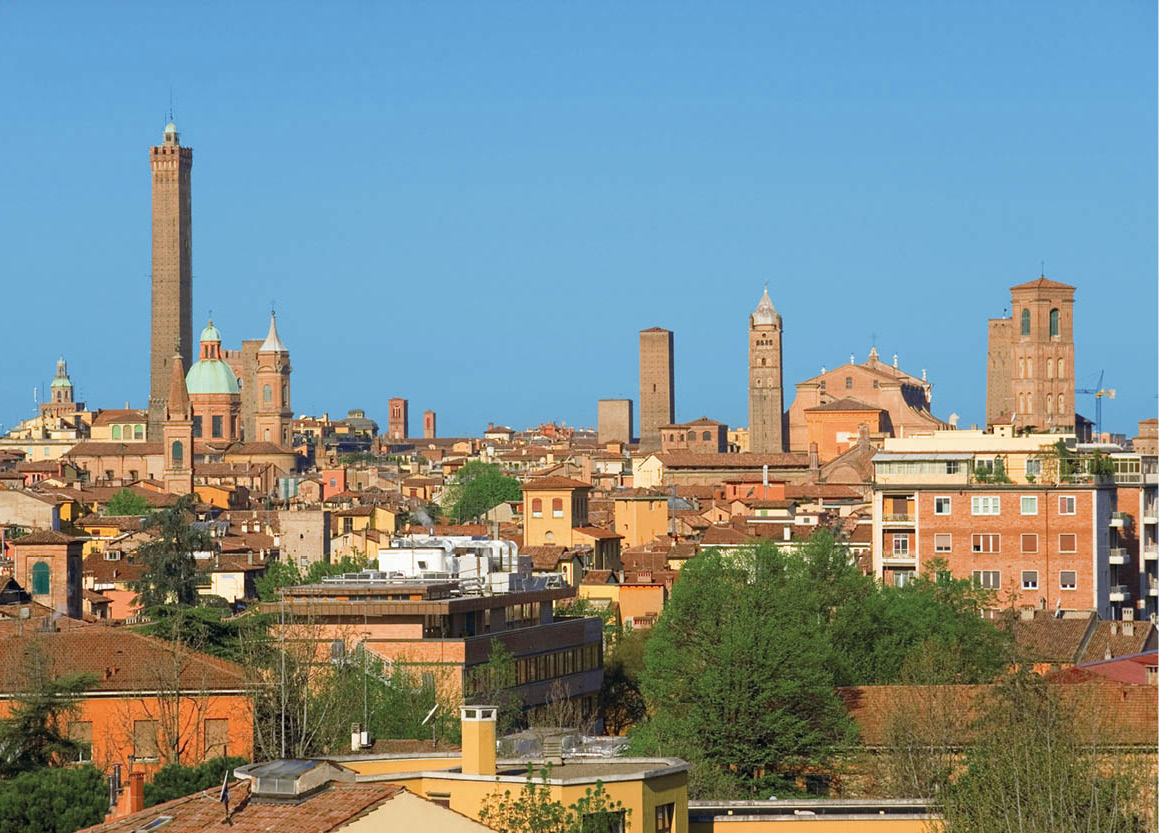
Bologna is famous for its ancient university and its cuisine.
iStockphoto
The Po Valley and Emilia-Romagna
The great plain of the Po Valley runs right across northern Italy, cut by irrigation channels and shivering with ghostly poplar trees. This fertile region between Milan in the west and Rovigo in the east is Italy’s larder as well as its fruit and vegetable garden. Emilia-Romagna on the south side of the valley, especially, is famed as having the finest cuisine in the country, and each town in the region has its own delicious specialities.
Italy’s longest highway, the Autostrada del Sole (“Motorway of the Sun”), begins at Milan and runs for 1,200km (780 miles) right down the length of the peninsula to Reggio di Calabria. As it leaves the Po Valley it skirts Modena ) [map]. A more ancient road, the Via Emilia, was built by the Romans, and still runs through the centre of Modena with the city’s most illustrious sight, the Romanesque Duomo (Cathedral), sitting grandly beside it. The Palazzo dei Musei contains several galleries, including the Galleria Estense (Tue–Sun) and the Biblioteca Estense (Mon–Sat), the library of the d’Este dukes of Modena. Modena’s great culinary speciality is balsamic vinegar, aceto di Modena, the quality of which is zealously regulated.
Eat
An excellent place to sample Bologna’s celebrated cooking is Buca del Petronio, Via de’ Musei 4, tel: 051-224 589, in an old palazzo a short walk from Piazza Maggiore, with an outside terrace. The atmosphere is relaxed, and the tortelloni with ricotta and other classic dishes, excellent.
Parma and Reggio Emilia, west of Modena, are the homes of dry-cured Parma ham and parmigiano (parmesan cheese) respectively. Further along the Via Emilia, the historic city of Bologna ! [map] is a prosperous place with a finely preserved historic centre and a well-deserved reputation for gastronomy. The city is centred around the grand Piazza Maggiore and Piazza del Nettuno, near which is the Mercato di Mezzo, one of the finest of all Italy’s food markets, with eye-popping stalls loaded with gourmet delights. To the east are the two Torri Pendenti (Leaning Towers), built by two aristocratic families in the 13th century who competed to build the tallest tower in the city. One is now only 48 metres (157ft) high, having been shortened for safety reasons in the 14th century, but still leaning distinctly; the other tower stands 97 metres (318ft) tall, and has 500 steps up for a rooftop view. Bologna’s university is the oldest in Europe, founded in 1088, and was attended by the great poet Petrarch (1304–74). Its official centre is the 16th-century Palazzo Poggi. Beyond the university, the Pinacoteca Nazionale (Tue–Sun) is a gallery mainly devoted to the Bolognese School, notably Carraci and Guido Reni.
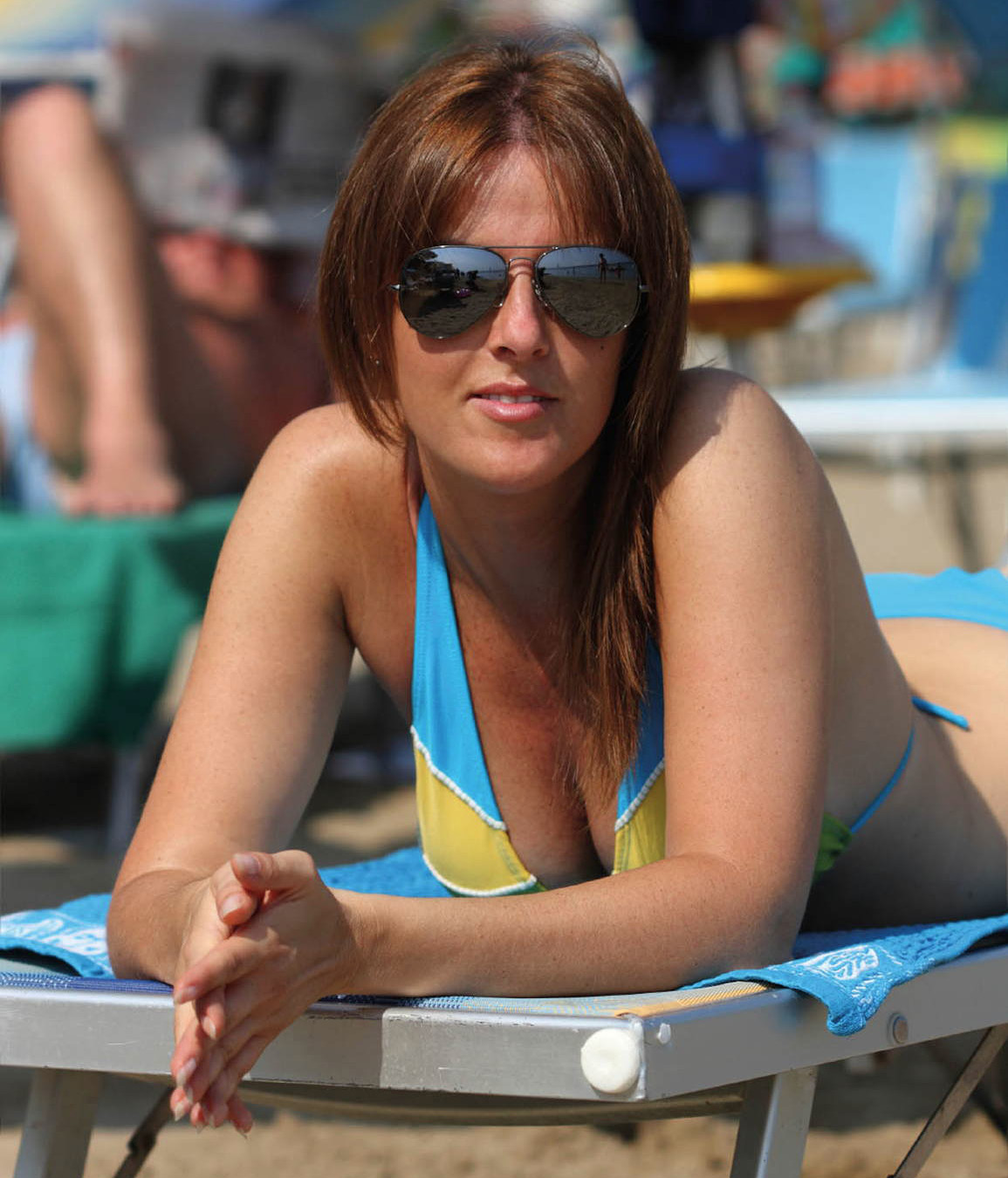
Sunbathing in Rimini on the northeast coast.
iStockphoto
The Adriatic
The main highway reaches the coast near Ravenna @ [map], which stands out from all other Italian cities for its churches with dazzling Byzantine mosaics. The city acquired these treasures in the 6th and 7th centuries, when under the Emperor Justinian (527–565) the Eastern Roman Empire regained control of part of Italy and made Ravenna the capital of its Italian territories. The finest mosaics are in the 6th-century Basilica of San Vitale (daily) and the 5th-century Mausoleum of Galla Placidia (daily).
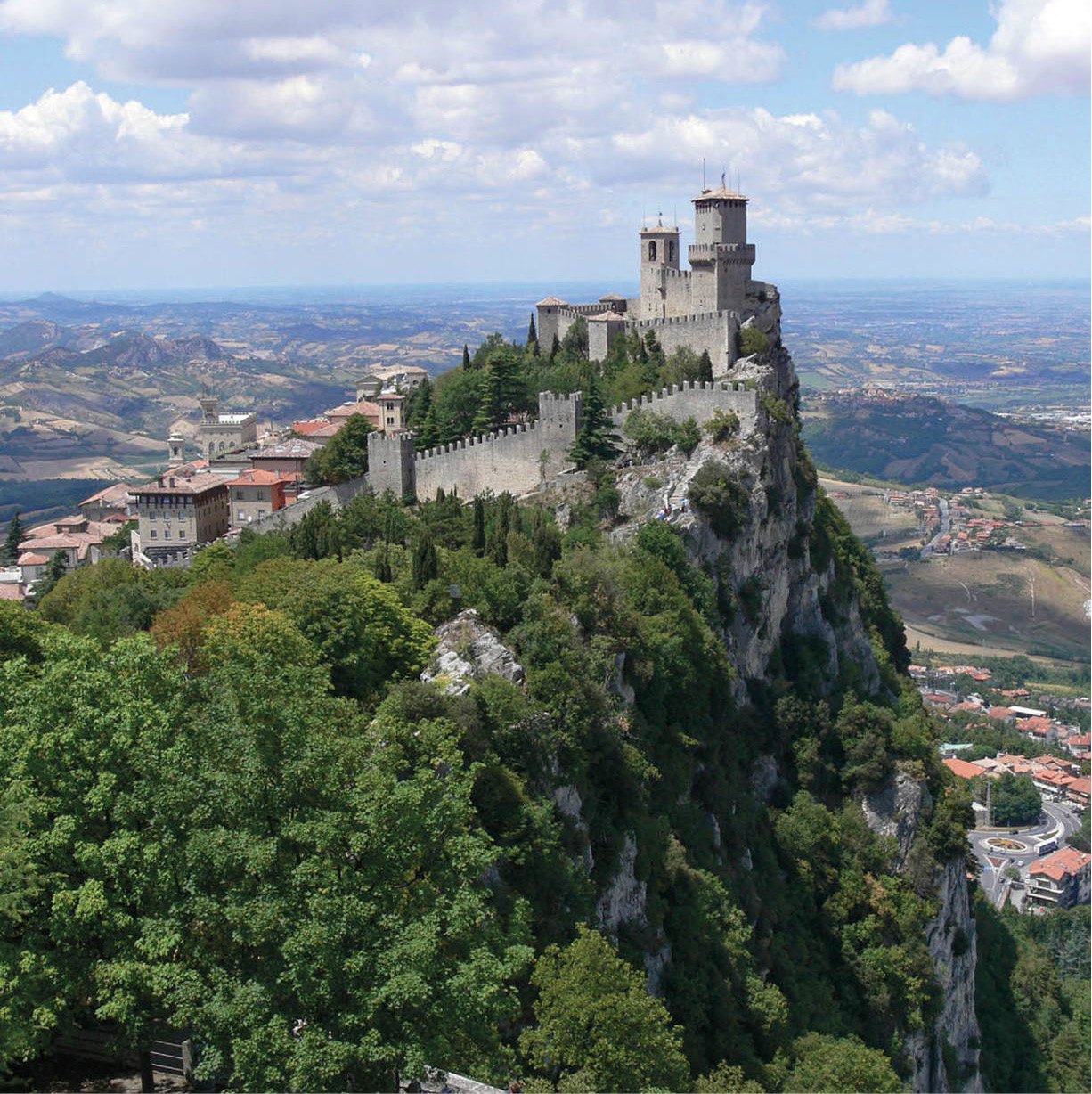
San Marino, Europe’s smallest republic.
iStockphoto
Stretching south are the sandy beaches of the Riviera Romagnola, Italy’s most popular beach holiday area. Rimini £ [map] is its principal resort. Millions come here each year to lie on the beach in rather expensive “beach clubs”, eat in the hundreds of restaurants and mingle in its nightclubs. It also has a cultural attraction: the Tempio Malatestiano (daily) Renaissance church, which was commissioned around 1450 by Sigismondo Malatesta. Rimini’s ruler and a condottiere (mercenary), Malatesta was condemned by the pope and the church was never finished, but it is now the city’s cathedral.
Half an hour’s drive inland from Rimini lies Europe’s oldest and smallest republic – San Marino $ [map]. It has just 29,000 inhabitants and is dramatically set on the rocky slopes of Monte Titano. To the southwest of San Marino stands the hilltop fortress of San Leo, a conspicuous sight that attracts thousands of visitors.
Tuscany presents the quintessential Italian landscape: medieval hilltop towns, silvery olive groves, neat vineyards carpeting gently rolling hills, and old farms and villas watched over by cypress trees. The beauty of the landscape, the intensity of the light and the natural harmony were the inspiration of Renaissance artists and architects in its capital, Florence % [map].
One of the main gateways to Tuscany is Pisa ^ [map], west of Florence and famous for its Leaning Tower (Torre Pendente) in the Campo dei Miracoli (Field of Miracles). Pisa is also renowned as one of Italy’s great cities of art. It was one of the most powerful Italian maritime republics in the early Middle Ages, aiding the Normans in their conquest of Sicily, but it was defeated by its great rival Genoa in 1284, and eclipsed by its neighbour Florence in the following century. The Campo dei Miracoli is a theatrical architectural ensemble built during the city’s golden age, and apart from the tower – now safe from falling since long-drawn-out rescue work was completed in 2001 – is home to the Baptistery and Duomo (Cathedral). It is the Islamic influence on the architecture of these buildings that makes them so distinctive, a legacy of the Pisan merchants who established important trading links with North Africa and Moorish Spain.
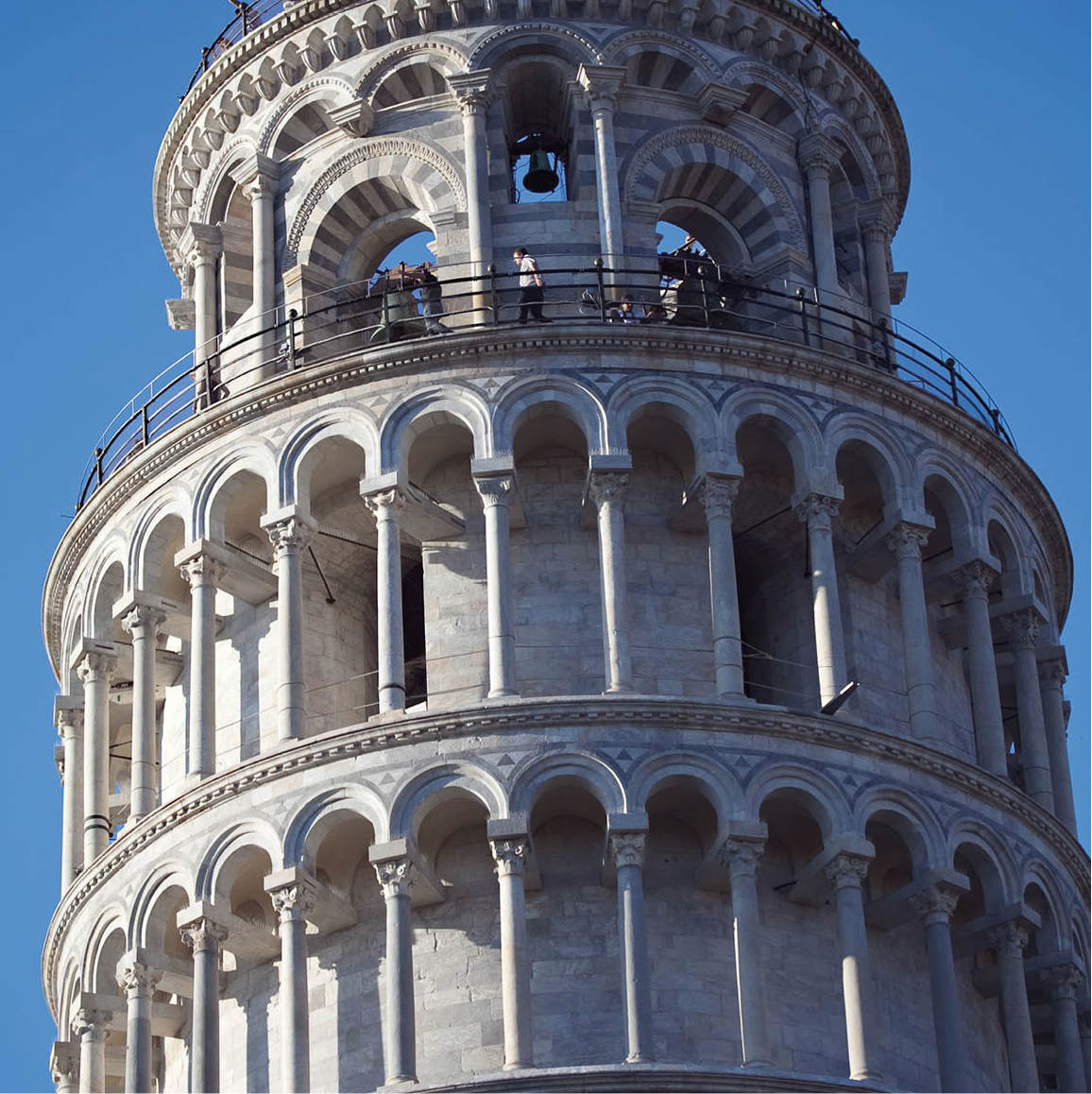
The Leaning Tower of Pisa – still leaning, but still standing.
South of Florence, Siena & [map] is a perfect medieval town of narrow lanes and alleys. The fan-shaped Piazza del Campo is one of the finest squares in Italy, a great place to enjoy a drink at one of the many pavement cafés or, if you’re here on 2 July or 16 August, to watch the fantastic scene of horses and their riders charging around the square in one of the wildest horse races in the world, the Palio. A colourful procession of pages, knights, flag-wavers and men-at-arms, all in 15th-century costumes, opens the spectacle. Riding bareback, the participants risk life and limb.
Tip
Visitor numbers at Pisa’s Leaning Tower are limited, so it’s advisable to book ahead, especially in summer. Bookings for all the monuments on the Campo dei Miracoli are made through the same website, www.opapisa.it.
The square slopes down to the graceful Gothic Palazzo Pubblico (town hall), with a crenellated facade and fluttering banners. This is now home to the Museo Civico (daily), housing outstanding early Renaissance art, including two great frescoes by Simone Martini and Ambrogio Lorenzetti’s Allegories of Good and Bad Government. The strenuous climb up 500 steps to the top of the slender Torre del Mangia (Belltower; daily) is worth it for the panorama of the city. The facade of Siena’s Gothic Duomo (Cathedral; daily) is a festival of green, pink and white marble, while the interior is decorated with black-and-white geometric patterns. A crypt (daily; guided tours only) below the Duomo is decorated with stunning Sienese School frescoes. Other fine examples of Sienese art can be found in the Pinacoteca Nazionale (daily), in the Palazzo Buonsignori on Via San Pietro, south of the Campo.
The best introduction to the Tuscan hill country is a tour of Chianti. The SR222 (Via Chiantigiana) from Siena leads north through the region amid rolling hillsides of vineyards of the famous estates that produce this classic Italian wine. A little to the west is San Gimignano, perhaps the archetypal Tuscan hill town, a “medieval Manhattan” bristling with extraordinary tall towers built by competing aristocratic families in the early Middle Ages. South of Siena is yet more gorgeous countryside with exceptionally beautiful hill villages known for fine wines and foods, especially Montalcino and Montepulciano.
East of Siena, Arezzo * [map] offers worthy relief from the rigours of the highway. The chief attraction lies in Piero della Francesca’s remarkable fresco cycle depicting The Legend of the True Cross in the Basilica di San Francesco (daily).
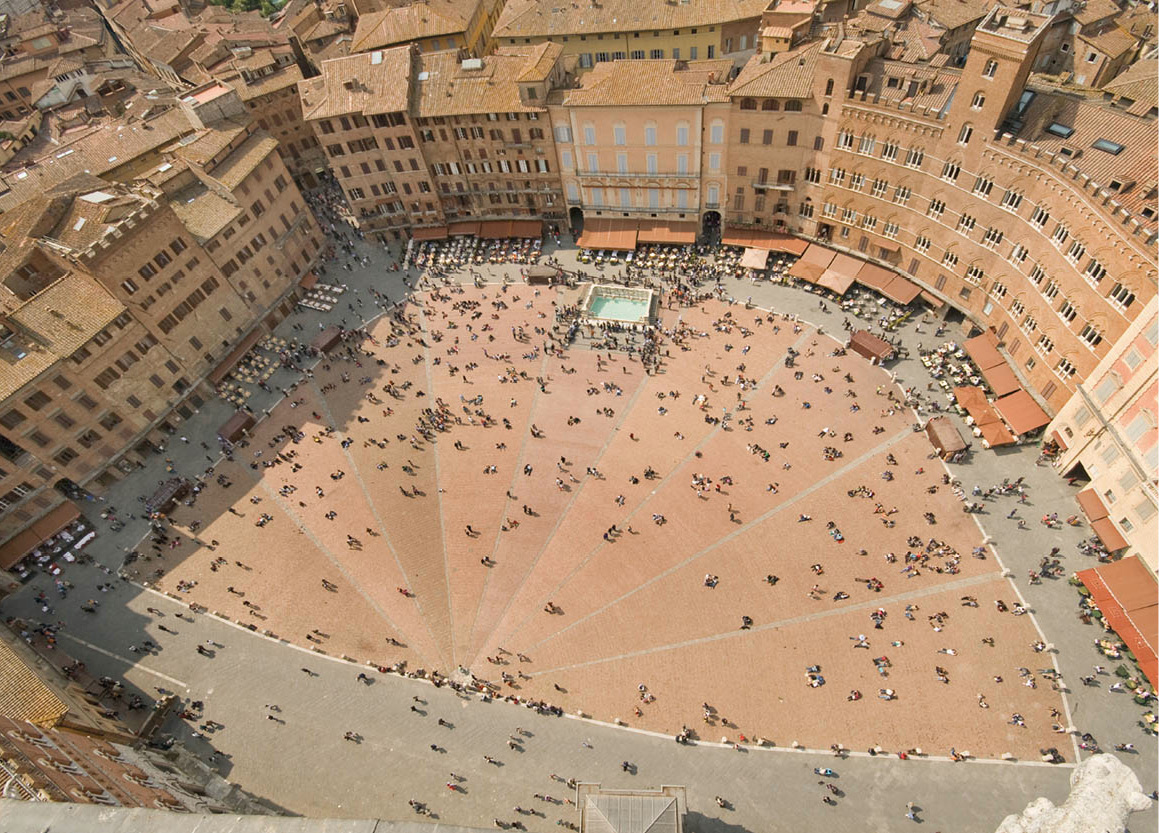
View of Siena’s Piazza del Campo from the Torre del Mangia.
iStockphoto
Umbria
To the east of Tuscany is the province of Umbria and its handsome capital, Perugia ( [map]. The city reflects the bellicose side of a region where the martial and the mystical are inextricably intertwined. Perugia’s churches were never completed by the same generation that created them, since the citizens were too busy with wars, feuds, pillage and murder.
If you have only enough time for one museum, make it the Galleria Nazionale dell’Umbria (Tue–Sun), which displays works by many of Umbria and Tuscany’s most noted painters; Fra Angelico and Piero della Francesca are both well represented. This barbed hilltop fortress town is also where Raphael studied under the great artist Pietro Perugino.
The tradition of fresco painting was established by the Florentine Giotto at Assisi ‚ [map]. This beautiful medieval town, with its famous frescoed basilica, is worth staying in for its unique atmosphere.
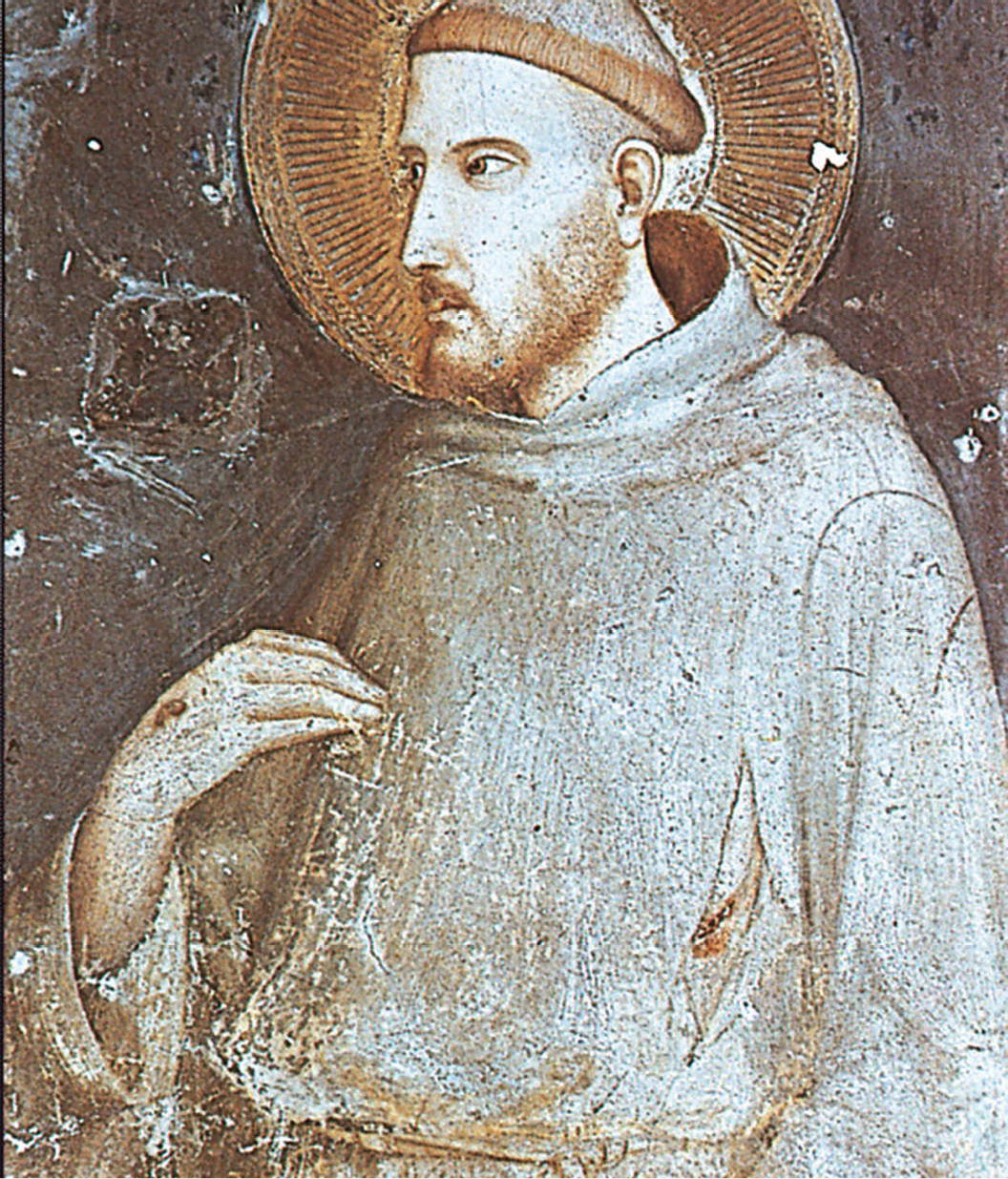
Fresco of St Francis in the Basilica of San Francesco, Arezzo.
Apa
St Francis of Assisi
The picture-postcard town of Assisi in Umbria, flower-decked and wood-smoke-scented, draws tremendous crowds, who come to experience something of the spiritualism of the Franciscan order, founded by the town’s most famous son, Francis of Assisi.
Born Giovanni Bernadone in 1181, Francis embraced asceticism at an early age, and by 1219 had a brotherhood of 5,000 monks. The main tenets of the original Franciscan order were poverty, chastity and obedience; in particular, Francis repudiated the decadence of the Catholic Church, posing a challenge to the worldliness of the papacy. On his return from preaching in the Holy Land, Francis is said to have received the marks of the stigmata, and was canonised in 1228, two years after his death.
Construction of the two-tiered Basilica di San Francesco (Basilica of St Francis; daily) began in the mid-13th century. The Basilica Inferiore (Lower Basilica; often closed) was built around the saint’s crypt and commemorates Francis’s modest life with frescoes by Simone Martini and Cimabue. The Basilica Superiore (Upper Basilica), contains Giotto’s famous fresco cycle of The Life of St Francis. It has been faithfully restored after damage caused by the 1997 earthquake, although it will never be quite what it was.
Naples and Campania
Some 240km (150 miles) south of Rome ⁄ [map] (Roma), the Bay of Naples reveals rich historic and scenic attractions. Founded by Greek colonists who named it “Neapolis” (the New City), Naples ¤ [map] (Napoli) was captured by the Romans in 326 BC, and enriched with temples, gymnasiums, arenas and all the luxuries of a major Roman city. Later it became a Byzantine dukedom, and the capital of a kingdom that became one of the territories of the Spanish crown. Often under foreign rulers, it was a place where laws were never taken too seriously.
Naples’s teeming streets, unemployment and widespread crime, and the increasing prevalence of the Camorra (the region’s own home-grown mafia) have not exactly given the city a positive image. Actual criminality aside, the traffic alone is insane. Nevertheless, Naples is still a city of stubborn vitality and theatricality, and continues to exert a fascination.
A good place to begin a tour is the Castel Nuovo (New Castle; Mon–Sat), where a stupendous Triumphal Arch stands in commemoration of Alfonso I’s 15th-century defeat of the French. From outside the castle, Via San Carlo leads to Italy’s largest opera house, the Teatro San Carlo. The Gothic Duomo (Cathedral) of Naples is sandwiched between apartment blocks in the north of the historic centre.
In the cathedral’s Chapel of San Gennaro is a treasured relic: a phial containing the blood of San Gennaro, martyred in AD 305. The blood must liquefy three times a year – on the first Saturday in May, on 19 September and on 16 December – if Naples is to escape disaster, and these ceremonies are highlights of the Neapolitan ecclesiastical year.

View of Naples from Castel Sant’Elmo.
Greg Gladman/Apa Publications
Among Naples’s many other churches is the 16th-century Gesù Nuovo, perhaps the most harmonious example of Neapolitan Baroque, and San Pietro a Maiella, with a ceiling painted by Mattia Preti between 1656 and 1661.
Naples’ great cultural highlight, though, is the Museo Archeologico Nazionale. Often known just as the Naples Museum (Wed–Mon), it is one of Italy’s greatest museums of Roman and Greek antiquities, housing the most spectacular finds from Pompeii and Herculaneum, wonderful mosaics and fine Greek sculpture. Two other excellent museums are the Museo di Capodimonte (Mon–Sat), in the Palazzo di Capodimonte once owned by Naples’s 18th-century kings, with delightful porcelain along with paintings by Titian and Caravaggio; and the Certosa di San Martino (Thur–Tue), a beautifully restored Carthusian monastery on the hill above the city, with spectacular views over Naples and its bay.
Looming over the Bay of Naples is the giant volcano of Vesuvius, which last erupted in 1944, with the remnants still scattered in a vast heap around the crater. The most famous explosion, however, occurred in AD 79, when the flourishing cities of Pompeii ‹ [map] and Herculaneum (both daily) were buried under a deep covering of ashes and brimstone. The last moments of Pompeii’s inhabitants and their daily life, preserved in volcanic ash, have come to light as archaeologists have excavated the remains: a rich man, his fingers still clutching the keys to the treasure chests his slaves carried behind him; wine in jugs on tables, bread baking in the oven; a dog in its death throes; graffiti proclaiming love, obscenities and political baiting. The details and richness of the ancient lives caught in that fateful event make Pompeii one of the world’s most impressive ancient monuments.
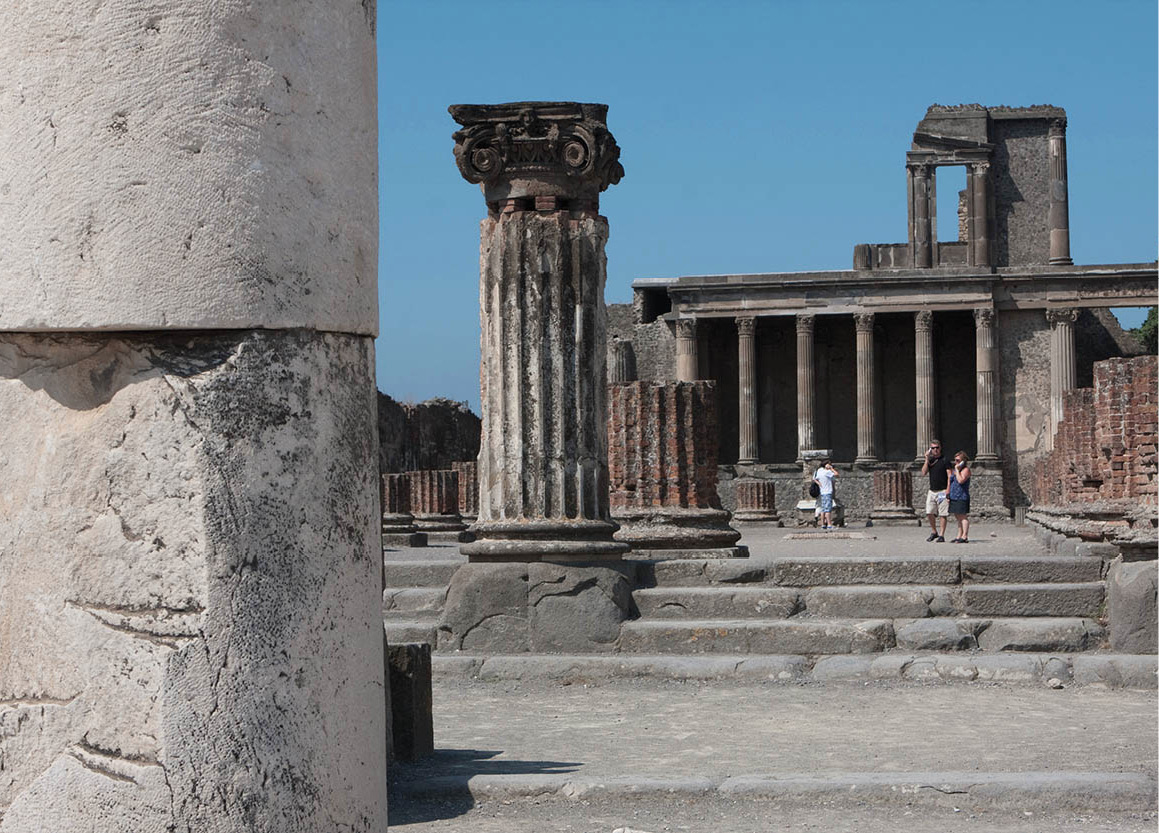
Exploring the remains of Pompeii.
Greg Gladman/Apa Publications
Some parts of the site are notoriously badly maintained, and the size of its tour groups can be dismaying, but a visit to lesser-known Herculaneum is one way of dealing with the problem. Although the town was smaller than Pompeii, there is still plenty to see, such as the well-preserved mosaics which decorate the Casa dell’Atrio Mosaico (House of the Atrium Mosaic) and the Casa dei Cervi (House of the Stags).
Around the eastern side of the Bay of Naples are more of Italy’s most famous landscapes. The island of Capri › [map] is easily reached by fast hydrofoil from Naples or Sorrento. Tiberius chose the island as his retirement home in AD 27, and while he may or may not have organised orgies on the island, the story has not diminished Capri’s appeal. The ruins of his luxurious imperial villa, Villa Jovis (daily), have spectacular sea views. But the most popular island excursion is the Grotta Azzurra (Blue Grotto; tickets for boat trip available from Marina Grande). The sun shining through the water in this cave creates a strange blue light, which has made it the most visited attraction in the region after Pompeii.

Boats moored off the coast of Capri.
Greg Gladman/Apa Publications
On the mainland lies Sorrento, the largest resort of the “Amalfi Coast” and the start of the extraordinary, twisting coast road, which winds round the rocky peninsula sometimes halfway up an almost sheer cliff. Travellers are rewarded by unforgettable views over the dazzlingly blue sea. The road dips into pretty villages that have become fashionable beach hideaways, such as Positano and Amalfi itself, before reaching the beautiful cliff-top village of Ravello.
Tip
The coast road between Sorrento and Amalfi can be quite stressful to drive and is perhaps best done by public bus. Tickets are valid for 24 hours and can be bought from a kiosk near Sorrento railway station; travelling east, be sure to sit on the right-hand side of the bus if you can.
Apulia and Calabria
Due east of Naples, the jutting peninsula of Puglia (Apulia) forms the heel of Italy’s boot. Bari fi [map] , originally a Greek colony, is its main commercial centre, but there is a wonderful absence of modernity in the warren of narrow streets and dazzling white houses in the ancient half of the city. Two sights are the fine Romanesque Basilica di San Nicola, built to house the bones of St Nicholas, brought back from Asia Minor in 1087 by local sailors; and the Pinacoteca Provinciale (Tue–Sun), devoted to local art. Picturesque Alberobello, 50km (30 miles) southeast of Bari, is a major tourist attraction, consisting almost entirely of Puglia’s distinctive trulli – single-storey, whitewashed shepherds’ huts with conical slate roofs.
The coastal road continues to Brindisi, where a column marks the end of the Via Appia, the greatest of the ancient roads that lead to Rome. Today, as in ancient times, this is the main ferry port between Italy and Greece.
Taranto fl [map], on the instep of Italy’s boot, and founded by Spartans in 706 BC, was once the largest Greek city in Italy. Its MARTA archaeological museum (daily) displays superb sculpture and Greek and Roman ceramics. In a region of restrained Romanesque architecture, the sumptuous buildings of Lecce ‡ [map] to the east come as something of a pleasant surprise. The flamboyant style of its 17th-century churches and palazzi became known as “Lecce Baroque”.
And so to the toe of the boot, and Reggio di Calabria ° [map], from where ferries between the mainland and Sicily arrive and depart. The first Greek settlers made the sea journey from Sicily in the 8th century BC; the most celebrated evidence of this early contact only came to light in 1972, when fishermen discovered two colossal Greek statues thought to have gone down with a ship. They are, deservedly, the chief exhibits in the Museo Nazionale della Magna Graecia (Tue–Sun).
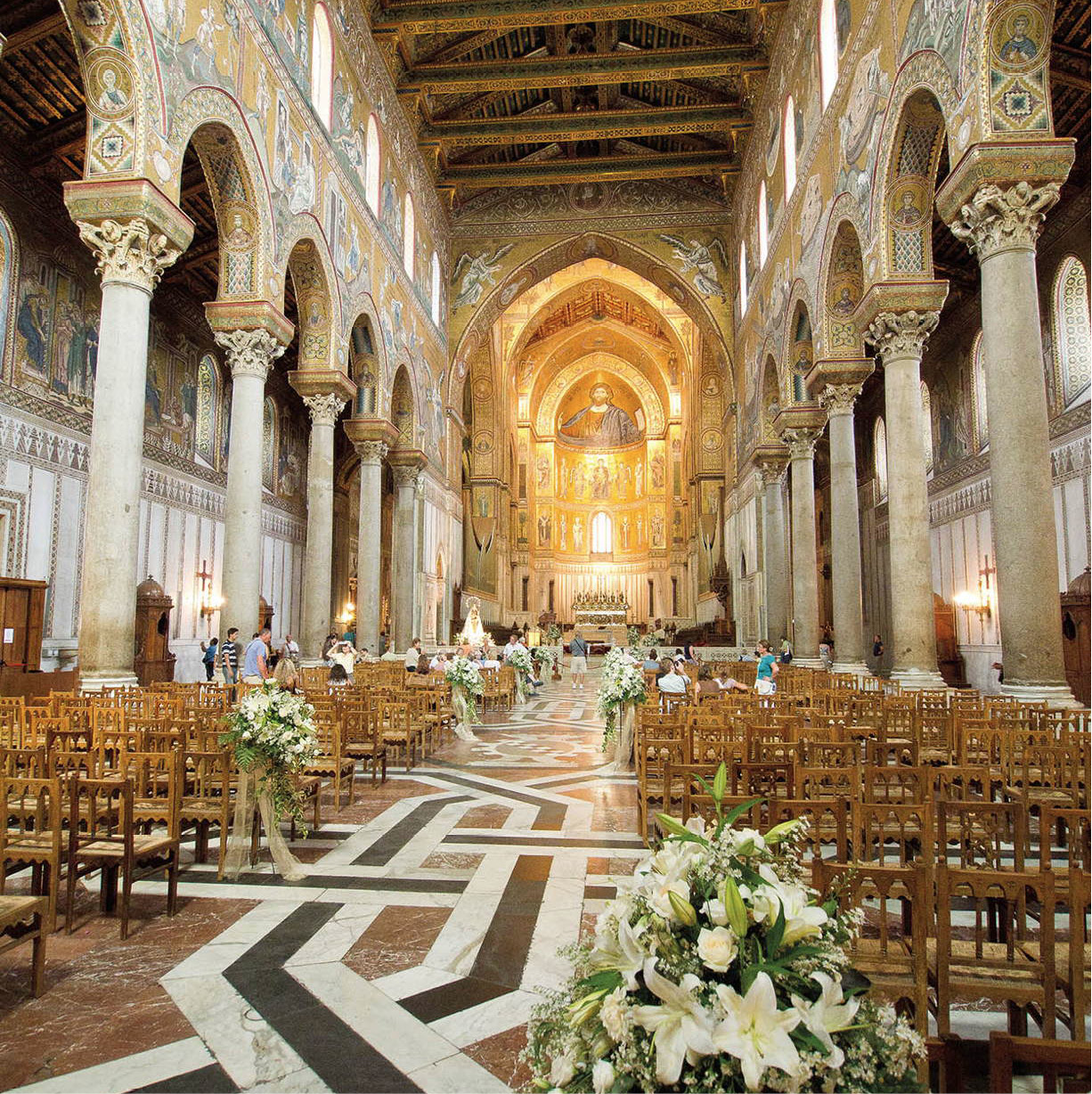
The interior of Monreale Cathedral, Sicily.
Neil Buchan-Grant/Apa Publications
Sicily and Sardinia
The fertile island of Sicily (Sicilia) has always been at the confluence of the Mediterranean world, It is best seen by road, although the ever-smouldering Mount Etna provides the most dramatic single vantage point. Around the central town of Enna, the countryside is one rolling plain of golden cornstalks.
Where
You can either climb Mount Etna or circle it on the Circumetnea private railway. This slow single-track train runs Monday to Saturday from Catania to Riposto, affording spectacular views of the volcano. For information go to www.circumetnea.it.
Palermo · [map], Sicily’s capital, is a turbulent place, known for both its Mafia connections and some wonderful architecture. The Palazzo dei Normanni, originally a Norman palace, is now the seat of the Sicilian Parliament, and contains the exquisite Capella Palatina (Palatine Chapel; Mon–Fri). Within easy reach of Palermo is the glorious Cathedral of Monreale (daily), which has some of the finest medieval mosaics in Europe. East of Palermo on the north coast is the pretty seaside town of Cefalù, with a surprisingly impressive 12th-century cathedral.
Siracusa º [map] (Syracuse) was one of the most important Greek colonies, and in its sprawling Parco Archeologica della Neapolis (daily) is a great Greek Theatre (Teatro Greco) that holds up to 15,000 spectators. High-quality classical performances are staged here each summer (details from tourist office). Even more spectacular is the Valle dei Templi (Valley of the Temples) at Agrigento ¡ [map]; the Temple of Concord is arguably the best-preserved Doric temple in the world.
Further up the coast, clinging to the cliffs, is pretty Taormina ™ [map]. This chic resort also has a Teatro Greco (daily), dramatically positioned above the village, that is also still in use for music and drama.
Off Sicily’s northeastern tip, the volcanic Aeolian Islands (Isole Eolie) include Stromboli, which spews lava into the night, and are where the Greeks believed the god Aeolus imprisoned the winds. The pace of life here is slow even in summer when tourists descend in their droves to “get away from it all”. The wild and rugged island of Sardegna # [map] (Sardinia) has been a world of its own virtually throughout its history. It would be hard to find a concentration of such enticing white beaches anywhere else in the Mediterranean, and while the coves of the northeast on the Costa Smeralda (“Emerald Coast”) are associated with the international elite, elsewhere around the island, such as north and south of the old Catalan town of Alghero, it’s easy to find swathes of beach to yourself. The interior is striking too, with wild gorges and valleys carved into it. The most distinctive of Sardinia’s cultural attractions are the nuraghi, Bronze Age stone towers. Their exact function is still unclear; they may have been dwellings, fortifications and sanctuaries, but nevertheless, these megaliths offer a tantalising glimpse of Sardinia’s early civilisation. Sardinia’s food and wine, though relatively little-known, are among Italy’s best.

